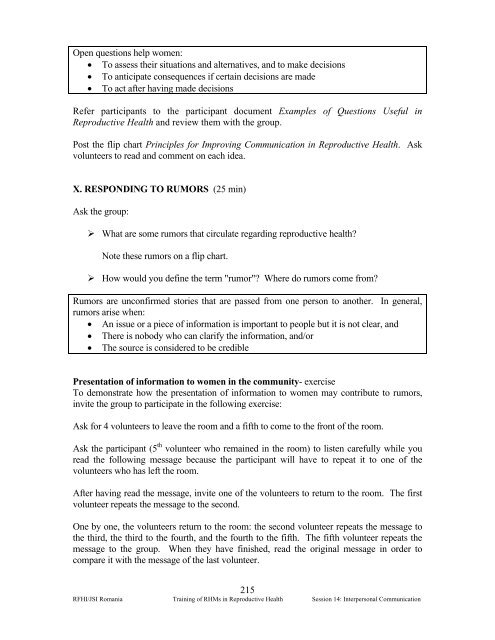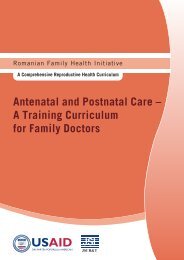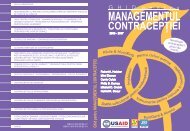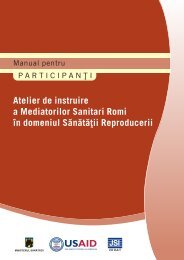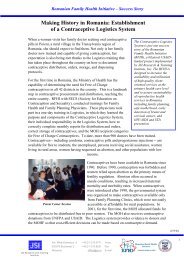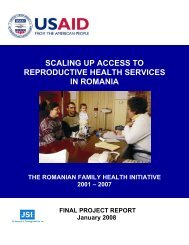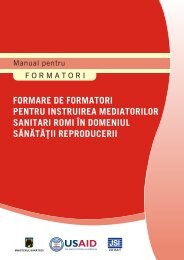Training of Roma Health Mediators in Reproductive Health
Training of Roma Health Mediators in Reproductive Health
Training of Roma Health Mediators in Reproductive Health
Create successful ePaper yourself
Turn your PDF publications into a flip-book with our unique Google optimized e-Paper software.
Open questions help women:<br />
• To assess their situations and alternatives, and to make decisions<br />
• To anticipate consequences if certa<strong>in</strong> decisions are made<br />
• To act after hav<strong>in</strong>g made decisions<br />
Refer participants to the participant document Examples <strong>of</strong> Questions Useful <strong>in</strong><br />
<strong>Reproductive</strong> <strong>Health</strong> and review them with the group.<br />
Post the flip chart Pr<strong>in</strong>ciples for Improv<strong>in</strong>g Communication <strong>in</strong> <strong>Reproductive</strong> <strong>Health</strong>. Ask<br />
volunteers to read and comment on each idea.<br />
X. RESPONDING TO RUMORS (25 m<strong>in</strong>)<br />
Ask the group:<br />
‣ What are some rumors that circulate regard<strong>in</strong>g reproductive health?<br />
Note these rumors on a flip chart.<br />
‣ How would you def<strong>in</strong>e the term "rumor"? Where do rumors come from?<br />
Rumors are unconfirmed stories that are passed from one person to another. In general,<br />
rumors arise when:<br />
• An issue or a piece <strong>of</strong> <strong>in</strong>formation is important to people but it is not clear, and<br />
• There is nobody who can clarify the <strong>in</strong>formation, and/or<br />
• The source is considered to be credible<br />
Presentation <strong>of</strong> <strong>in</strong>formation to women <strong>in</strong> the community- exercise<br />
To demonstrate how the presentation <strong>of</strong> <strong>in</strong>formation to women may contribute to rumors,<br />
<strong>in</strong>vite the group to participate <strong>in</strong> the follow<strong>in</strong>g exercise:<br />
Ask for 4 volunteers to leave the room and a fifth to come to the front <strong>of</strong> the room.<br />
Ask the participant (5 th volunteer who rema<strong>in</strong>ed <strong>in</strong> the room) to listen carefully while you<br />
read the follow<strong>in</strong>g message because the participant will have to repeat it to one <strong>of</strong> the<br />
volunteers who has left the room.<br />
After hav<strong>in</strong>g read the message, <strong>in</strong>vite one <strong>of</strong> the volunteers to return to the room. The first<br />
volunteer repeats the message to the second.<br />
One by one, the volunteers return to the room: the second volunteer repeats the message to<br />
the third, the third to the fourth, and the fourth to the fifth. The fifth volunteer repeats the<br />
message to the group. When they have f<strong>in</strong>ished, read the orig<strong>in</strong>al message <strong>in</strong> order to<br />
compare it with the message <strong>of</strong> the last volunteer.<br />
215<br />
RFHI/JSI <strong>Roma</strong>nia <strong>Tra<strong>in</strong><strong>in</strong>g</strong> <strong>of</strong> RHMs <strong>in</strong> <strong>Reproductive</strong> <strong>Health</strong> Session 14: Interpersonal Communication


